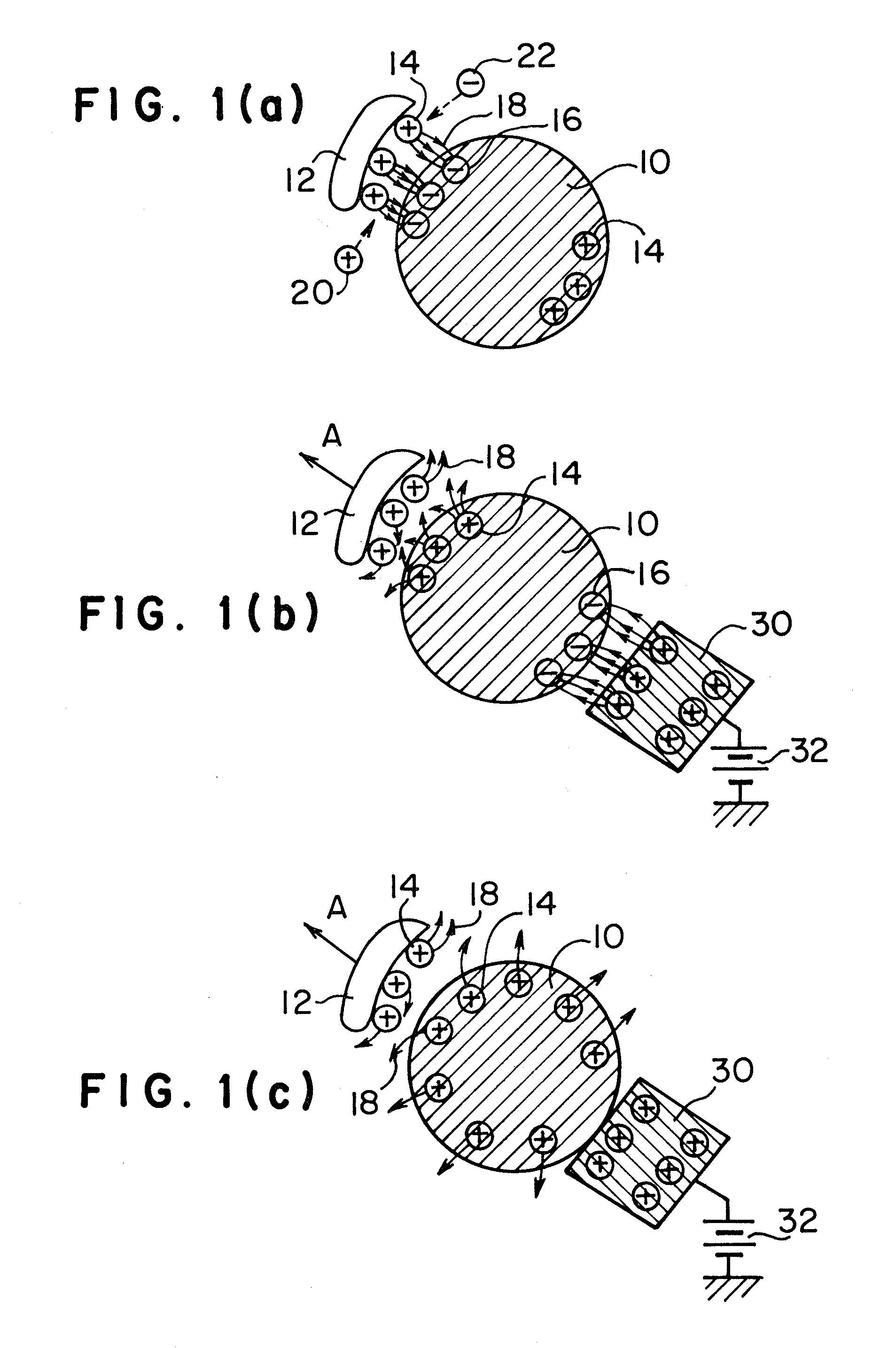Dust remover
a technology of dust removal and dust removal device, which is applied in the direction of carpet cleaners, cleaning processes and apparatuses, cleaning using liquids, etc., can solve the problems of difficult non-contact dust removal, dust is difficult to remove, and dust is adhered
- Summary
- Abstract
- Description
- Claims
- Application Information
AI Technical Summary
Benefits of technology
Problems solved by technology
Method used
Image
Examples
first embodiment
[0040]FIG. 1 is a view for explanation on mechanism of dust removal in case that the object of dust removal is a conductor, FIG. 1a shows the state that the dust is attached to the object of dust removal, FIG. 1b is a view for explanation on mechanism of non-contact system for dust removal. Although, for clarity of principle, in FIG. 1 the object of dust removal and dust are separately shown to show plus electric charge, minus electric charge, and electric flux line, in fact the dust is attached to the object of dust removal. In FIGS. 2 and 3 the object of dust removal and dust are shown the same as that of FIG. 1.
[0041]In FIG. 1a, when the dust 12 charged with plus electricity 14 approaches to or is attached to the object of dust removal, equal quantity of plus electricity 14 and minus electricity 16 are induced inside the object of dust removal. While the minus electricity 16 thus induced moves to the position adjacent the dust, the plus electricity 14 is pushed toward the opposit...
second embodiment
[0046]FIG. 2 is a view for explanation on mechanism of dust removal in case that the object of dust removal is an insulator, FIG. 2a shows the state that the dust is attached to the object of dust removal, FIG. 2b is a view for explanation on the mechanism in which the dust is removed from the side dust is attached and FIG. 2c is a view for explanation on the mechanism in which the dust is removed from the side opposite to that dust is attached.
[0047]In FIG. 2a, when the dust 12 charged with plus electricity 14 approaches to an insulator 40, that is, the object of dust removal charged with minus electricity 16, the dust 12 and the object of dust removal 40 attract to each other due to the attracting force generated between the plus electricity 14 with which the dust is charged and the minus electricity 16 with which the object of dust removal is charged, and as a result the dust 12 is attached to the object of dust removal 40.
[0048]In FIG. 2b, when the electrode 30 applied with minu...
third embodiment
[0050]FIG. 3 is a view for explanation on types of voltage applied to remove dust, FIG. 3a shows the state that the dust is attached to the object of dust removal, FIG. 3b shows that the applied voltage is a pulse DC, FIG. 3c shows that the applied voltage is a AC, FIG. 3d shows that the applied voltage is a plus DC, and FIG. 3e shows that the applied voltage is a minus DC.
[0051]In FIG. 3, the electric charge or electricity with which the dust is charged is in general of plus and / or minus polarity. In order to remove the dust 12 the voltage of plus and / or minus polarity is required. For this reason, a pulse DC, an AC or alternate current, plus DC or plus direct current, or minus DC is used.
[0052]Furthermore, although FIG. 3a shows that the voltage is applied while the electrode 30 is in contact with the conductor, or the object of dust removal 10. As the object of dust removal, either of a conductor and an insulator can be adopted, and similar voltages can be applied without contact...
PUM
 Login to View More
Login to View More Abstract
Description
Claims
Application Information
 Login to View More
Login to View More - R&D
- Intellectual Property
- Life Sciences
- Materials
- Tech Scout
- Unparalleled Data Quality
- Higher Quality Content
- 60% Fewer Hallucinations
Browse by: Latest US Patents, China's latest patents, Technical Efficacy Thesaurus, Application Domain, Technology Topic, Popular Technical Reports.
© 2025 PatSnap. All rights reserved.Legal|Privacy policy|Modern Slavery Act Transparency Statement|Sitemap|About US| Contact US: help@patsnap.com



